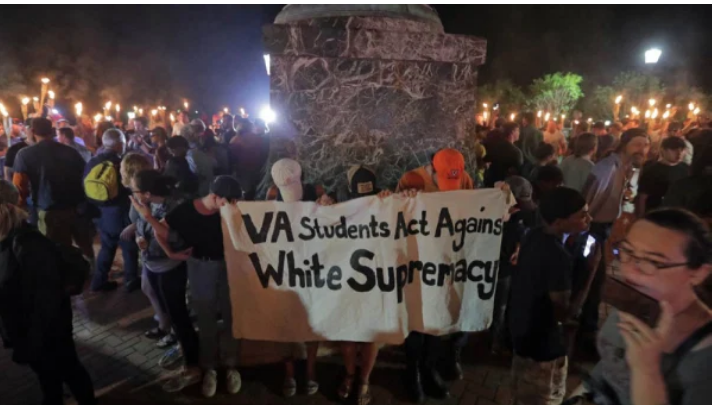On the Overwhelming Power of Nonviolent Resistance.

 American politics are becoming violent. But peaceful movements have power.
American politics are becoming violent. But peaceful movements have power.
It’s important to remember that meaningful and lasting change has rarely been brought forth by the violent hands of young men.
Murderous violence accompanied a planned race riot organized by neo-Nazi and white supremacist groups (please, let’s stop calling what took place a “rally”) in Charlottesville, Virginia, last weekend. Many more such events are now planned to take place across the country.
At least part of the American public appropriately holds Donald Trump and his administration accountable for these events, which by Sunday contributed to Trump’s job approval rating falling to a mere 34% – the lowest of his administration and the lowest rating in Gallup’s history for any newly elected president at this stage of a presidency.
Even before these horrors, Trump’s base was shrinking, with a mere 18% of those polled identifying themselves as “a strong Trump supporter” at the end of last month, compared to 22% in February. Those who counted themselves among the active resistance to Trump, meanwhile, grew from 35% to 41% over the same period.
Not that long ago, then candidate Trump lamented to a crowd of his supporters in Las Vegas that protesters could no longer be “carried out on stretchers”. And since January, conservative news sites including the Daily Caller and Fox Nation carried an article (which they later removed) subtitled: “Here’s A Reel Of Cars Plowing Through Protesters Trying To Block The Road.”
“Embedded in the article,” reports CNN, “was a minute-and-a-half long video showing one vehicle after another driving through demonstrations. The footage was set to a cover of Ludacris’ Move Bitch.”
It looks like we may have to expect growing violence on the part of Trump’s ever shrinking yet increasingly emboldened supporters. That’s a troubling prospect, especially with an administration that fails to differentiate between neo-Nazi aggressors and civilian groups seeking to defend themselves.
Yet now more than ever, it’s important to remember that meaningful and lasting change has rarely been brought forth by the hands of young men who carry out violence, but rather by the people bravely moving forward in nonviolent resistance.
The power of nonviolent civil resistance has been convincingly argued by professors Erica Chenoweth and Maria J Stephan in their now classic 2014 essay, Drop Your Weapons: When and Why Civil Resistance Works (an update of their 2011 book, Why Civil Resistance Works). Chenoweth then updated that analysis, sharing it in a lengthy interview with the Nation in February on the most effective tactics for confronting the Trump regime.
Having assembled a first-of-its-kind data set of all 323 nonviolent and violent campaigns from 1900 to 2006 for self-determination, the removal of an incumbent leader, or the expulsion of a foreign military occupation, Chenoweth and Stephan unequivocally conclude:
“Campaigns of nonviolent resistance against authoritarian regimes were twice as likely to succeed as violent movements. Nonviolent resistance also increased the chances that the overthrow of a dictatorship would lead to peace and democratic rule. This was true even in highly authoritarian and repressive countries, where one might expect nonviolent resistance to fail.”
Chenoweth described Trump as having “demagogic aspects of his behavior” and warned of the importance of recognizing “the broader authoritarian currents in the American polity that put him in power”.
The main problem with violent movements – defined as armed and/or threatening or causing physical harm to others – is that they are generally limited to just young, able-bodied men (often able to commit an act of violence and promptly leave the scene unscathed).
While they “succeed” in unleashing “terrible destruction and bloodshed”, they generally fail to realize their goals in both the short and the long term, the researchers find. The primary reason is that they lack diversity in ideas, tactics and abilities.
This homogeneity leads to a host of limitations on success, from the range of costs they can exact on the oppressor to the ability to form the coalitions required to sustain a movement, or envision and run new frameworks, institutions or governments.
And as Martin Luther King Jr observed, “violence begets violence” – where there is one group of young men willing to fight, there is likely another with the opposing view, willing to take them on.
Nonviolent movements, on the other hand, succeed because they attract more and more diverse people, including women, religious figures, civil servants and government defectors. They are more sustainable thanks to their numbers and their diversity of tactics.
The use of civil disobedience and “disruption”, otherwise known as nonviolent direct action, are the keys to their success. Chenoweth and Stephan offer many examples of both creative and risky direct actions from around the world, such as people laying down across railroad tracks outside the city of Dnipropetrovsk, Ukraine, to prevent a train carrying 500 elite riot police from entering Kiev in 2013.
“When large numbers of people engage in acts of civil disobedience and disruption, shifting between concentrated methods such as protests and dispersed methods such as consumer boycotts and strikes, even the most brutal opponent has difficulty cracking down and sustaining the repression indefinitely,” Chenoweth and Stephan write.
“Civil resistance does not succeed because it melts the hearts of dictators and secret police,” they find. “It succeeds because it is more likely than armed struggle to attract a larger and more diverse base of participants and impose unsustainable costs on a regime.”
In fact, one of the most successful tools used by oppressors to outmaneuver opponents, Chenoweth and Stephan conclude, is to provoke them to take up arms.
Ultimately, nonviolent movements are more future-oriented, willing and able to plan for what to do after the overthrow and having the capacity to make that happen. They would also seem to be the most powerful tool for confronting violence.
As King’s statement is now increasingly supported by scientific studies identifying the spread of violence as like a contagion, moving from person to person. “The more you fill the environment with stimuli that are associated with violence, the more likely violence is to occur,” concludes social psychologist Bruce Bartholow.
Like a disease, therefore, the spread of violence is best halted by a wall of healthy – or nonviolent – people.
Diversity, inclusion, creativity: these, then, are the sources of strength for the resistance in the US, whether its confronting the Trump regime in the White House, or the neo-Nazis bearing torches and weapons in the streets.
Read more of Antonia’s works published in The Guardian here.
